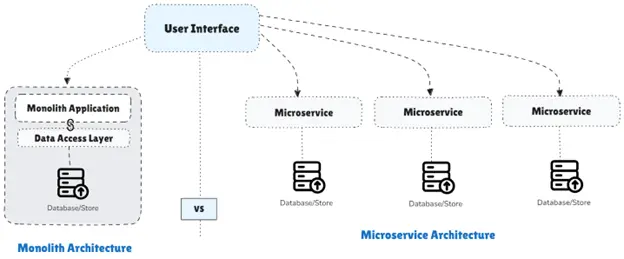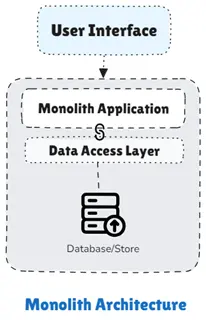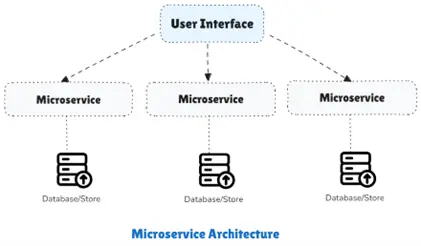Introduction
In the world of software development, the choice of architecture plays a crucial role in how applications are built, deployed, and maintained. Traditionally, many applications have been built using a monolithic architecture—a single, unified codebase where all components are interconnected. This approach, while straightforward and effective for smaller applications, can quickly become a bottleneck as the application scales in size, features, and user base.
In recent years, microservices architecture has emerged as a compelling alternative to the monolithic approach. Rather than a single, interdependent system, a microservices architecture breaks down the application into smaller, loosely coupled services.

What is a Monolith Architecture?
Monolithic architecture consists of a single, unified codebase where all components (UI, business logic, data access) are tightly integrated.
Advantages:
- Simplicity: Easy to set up, develop, and maintain in smaller applications.
- Ease of Deployment: Only one deployment package, making deployment straightforward.
- Centralized Management: Easier to manage and monitor as it’s a single unit.
Monolithic architecture is often a good starting point for small or simple applications but can become challenging to scale and modify as the application grows.

Advantages of Monolithic Architecture:
- Simplicity:
- Easier to develop and deploy initially. All components are in one codebase, which simplifies development.
- Ideal for smaller applications with fewer moving parts.
- Performance:
- Since everything is tightly coupled, communication between components within the monolith is faster (no network latency).
- Ease of Testing:
- Testing is more straightforward because there is only one application to test, and components are inherently well-integrated.
- Centralized Management:
- It’s easier to manage and deploy as a single unit, which simplifies operations for smaller teams.
- Less Overhead:
- No need for complex infrastructure (like orchestration, service discovery, etc.) that microservices require.
Challenges of Monolithic Architecture
- Scalability: As the application grows, scaling becomes difficult. To handle more traffic, you often need to scale the entire application, even if only a small part needs more resources. This is inefficient and costly.
- Reliability: In a monolithic system, all components are tightly integrated. A bug or issue in one part of the application can cause the entire system to fail.
- Deployment: With a monolithic application, even small updates require redeploying the entire system. This makes continuous delivery and frequent updates challenging.
- Limited Flexibility: A monolithic application is built using a single tech stack. If you want to integrate a new technology or framework, it’s often complicated or impossible without significant rework of the entire codebase.
These challenges make monolithic architectures less suitable for large, dynamic applications that require flexibility, scalability, and rapid iteration.
Introduction to Microservices:
- Microservices architecture is a style of software design where an application is built as a collection of small, independent services. Each service is responsible for a specific business function and operates autonomously.
- These services communicate with each other over a network, typically using APIs (REST, gRPC, etc.) to exchange data.
Microservices represent a shift towards a more modular and flexible architecture, ideal for handling complex and large-scale applications. However, they also bring new challenges, such as handling inter-service communication, ensuring data consistency, and managing deployments.

Why Use Microservices Over Monoliths?
- Scalability
○ Monolith: In a monolithic architecture, scaling the application means replicating the entire system, even if only one part of the application is under heavy load. This is inefficient and resource-intensive.
○ Microservices: Microservices allow you to scale individual services independently, ensuring resources are efficiently allocated to the parts of the application that need them the most. This makes it easier to scale your system based on specific demands. - Fault Isolation
○ Monolith: In a monolithic architecture, a bug or failure in one part of the application can cause the entire system to crash. This means the whole application is vulnerable to any issue in any component.
○ Microservices: Each microservice is isolated, so if one service fails, the rest of the system remains unaffected. This makes microservices more resilient and reduces the risk of widespread system downtime. - Faster Deployment Cycles
○ Monolith: In a monolithic system, making changes or deploying updates often requires redeploying the entire application. This can slow down development and increase the risk of bugs affecting other parts of the system.
○ Microservices: Since microservices are independently deployable, small teams can work on and release updates for individual services without affecting the rest of the system. This leads to faster, more frequent deployment cycles and quicker iteration. - Better Team Structure and Ownership
○ Monolith: With a monolithic system, the large, interconnected codebase can make it harder to assign clear ownership of specific parts of the application. This can lead to confusion over responsibilities and slower development.
○ Microservices: Microservices promote a clear division of responsibilities. Each service is owned by a specific team, which helps foster accountability and expertise in that area. Teams can focus on their services independently, leading to more efficient and focused development. - Flexibility in Tech Stack
○ Monolith: A monolithic architecture typically uses a single tech stack across the entire application. If a new technology or framework is needed, the whole application may require rework, which can be time-consuming and costly.
○ Microservices: Microservices offer the flexibility to use different technologies for different services.
Disadvantages of Microservices:
- Complexity:
○ Microservices introduce complexity in terms of system design, management, and communication. Each service needs to be monitored, managed, and maintained separately. - Inter-Service Communication:
○ Microservices rely on inter-service communication (via HTTP, messaging queues, etc.), which can introduce latency and complexity in handling failures and data consistency. - Data Consistency:
○ Maintaining data consistency across multiple services can be difficult, especially if each service has its own database. Techniques like eventual consistency must be used, which can complicate development. - Deployment Overhead:
○ Unlike monolithic systems that are deployed as a single unit, microservices require orchestration tools like Docker, Kubernetes, or a service mesh, adding overhead to deployments. - Testing:
○ While each service is easier to test individually, the integration between multiple services can be challenging. End-to-end testing can become complex, requiring specialized tools and infrastructure.
When to Choose Microservices?
Microservices are suitable for large, complex applications with the following needs:
- Large Applications: Microservices break down complex apps into manageable services, making maintenance easier and more organized.
- Independent Scalability: Services can be scaled independently based on demand, improving efficiency and cost-effectiveness.
- Frequent Updates: Microservices enable continuous deployment with independent service updates, reducing downtime and speeding up releases.
- Distributed Teams: Teams can work on separate services concurrently, enhancing collaboration and productivity.
- Technology Flexibility: Different services can use the best-suited technology stack for specific tasks, optimizing performance.
Conclusion
Microservices offer significant benefits for large, complex applications, such as improved scalability, independent service deployment, and fault isolation. They are ideal for teams that need flexibility, faster releases, and the ability to scale specific parts of the application. However, microservices introduce added complexity, especially for smaller applications, and may require more resources to manage.
Ultimately, choosing between monolithic and microservices architectures should be based on your application’s size, complexity, and specific needs. It’s essential to weigh the trade-offs and choose the model that best supports your goals for scalability, development speed, and long-term maintenance.

